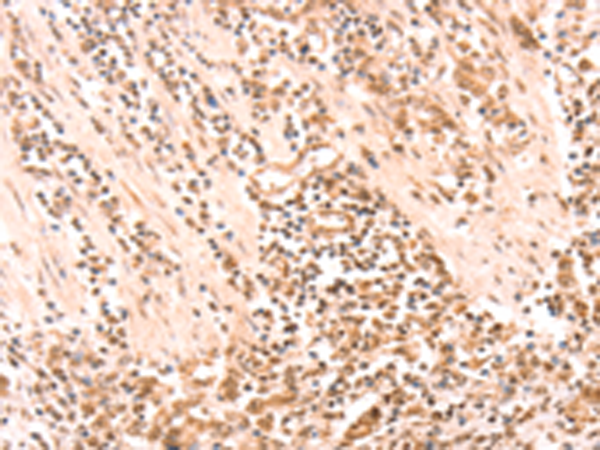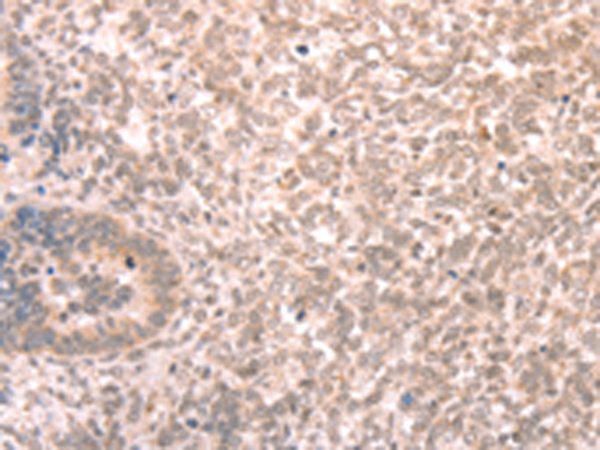

| WB | 咨询技术 | Human,Mouse,Rat |
| IF | 1/20-1/50 | Human,Mouse,Rat |
| IHC | IHC:1/100-1/200;IHF:1/50-1/200 | Human,Mouse,Rat |
| ICC | 1/50-1/200 | Human,Mouse,Rat |
| FCM | 1/20-1/100 | Human,Mouse,Rat |
| Elisa | 咨询技术 | Human,Mouse,Rat |
| Aliases | AMD; SAMDC; ADOMETDC |
| Host/Isotype | Rabbit IgG |
| Antibody Type | Primary antibody |
| Storage | Store at 4°C short term. Aliquot and store at -20°C long term. Avoid freeze/thaw cycles. |
| Species Reactivity | Human, Mouse, Rat |
| Immunogen | Synthetic peptide of human AMD1 |
| Formulation | Purified antibody in PBS with 0.05% sodium azide and 50% glycerol. |
+ +
以下是关于CRMP2抗体的3篇参考文献及其摘要:
---
1. **标题**:*CRMP2 Hyperphosphorylation in Alzheimer's Disease: A Link to Neurodegeneration*
**作者**:Hensley K, et al.
**摘要**:该研究探讨了阿尔茨海默病患者脑组织中CRMP2蛋白的异常磷酸化现象,发现其与神经元退行性变相关。通过使用特异性CRMP2抗体,作者揭示了磷酸化CRMP2在tau蛋白病理中的潜在作用,提示其可能成为治疗靶点。
---
2. **标题**:*Phosphorylation of CRMP2 Regulates Axonal Outgrowth via Microtubule Dynamics*
**作者**:Fukata Y, et al.
**摘要**:本文利用CRMP2抗体研究其磷酸化状态对轴突生长的调控机制。实验表明,磷酸化CRMP2通过影响微管稳定性抑制神经元极性形成,为神经损伤修复提供了分子机制依据。
---
3. **标题**:*CRMP2 as a Biomarker in Metastatic Cancer: Antibody-Based Detection in Clinical Samples*
**作者**:Bretin S, et al.
**摘要**:研究开发了一种高特异性CRMP2抗体,用于检测多种癌症患者的组织样本。结果显示,CRMP2表达水平与肿瘤转移能力正相关,提示其可作为预后标志物或治疗靶点。
---
4. **标题**:*Targeting CRMP2 with Neutralizing Antibodies Attenuates Neuropathic Pain in Rodent Models*
**作者**:Yu X, et al.
**摘要**:该研究通过注射CRMP2中和抗体,显著缓解了小鼠神经病理性疼痛模型中的痛觉过敏。机制研究表明,抗体通过阻断CRMP2与电压门控钠通道的相互作用发挥镇痛作用。
---
这些文献涵盖了CRMP2抗体在疾病机制、治疗开发和生物标记物研究中的应用。
CRMP2 (Collapsin Response Mediator Protein 2), also known as DPYSL2 or ULIP2. is a cytosolic phosphoprotein predominantly expressed in the nervous system. It belongs to the CRMP family, which comprises five isoforms (CRMP1-5) involved in neuronal development, axon guidance, and synaptic plasticity. CRMP2 plays a critical role in regulating microtubule dynamics, neurite outgrowth, and neurotransmitter release by interacting with tubulin heterodimers, kinases, and synaptic vesicle proteins. Its activity is modulated by post-translational modifications, particularly phosphorylation by kinases like GSK-3β and Cdk5. which influence its functional states.
CRMP2 antibodies are widely used as research tools to detect and study the protein's expression, localization, and interactions in both physiological and pathological contexts. Dysregulation of CRMP2 has been implicated in neurological disorders, including Alzheimer’s disease, epilepsy, neuropathic pain, and spinal cord injury. For instance, hyperphosphorylated CRMP2 is associated with amyloid-beta toxicity in Alzheimer’s models, while its cleavage by calpain contributes to axonal degeneration post-injury.
In therapeutic research, CRMP2 antibodies help validate its role as a biomarker or drug target. Small molecules like lacosamide (an antiepileptic) are known to modulate CRMP2-mediated pathways, highlighting its translational potential. However, cross-reactivity with other CRMP isoforms remains a technical consideration. Overall, CRMP2 antibodies serve as essential reagents for unraveling neural mechanisms and developing targeted therapies for neurological diseases.
×